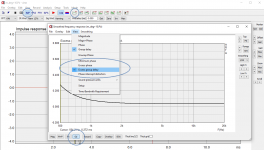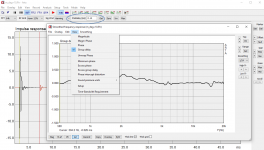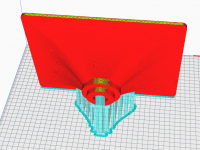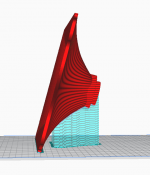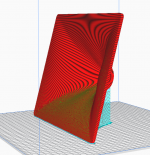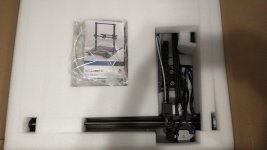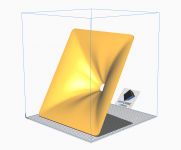Well, Your Excess Group Delay is simply Group Delay then. Why call it something else?
For a minimum phase system (and the excess group delay is the way how to check that) this is simply an equivalent of its magnitude response. And of course correctable by EQ, all at once. We are talking about a waveguide alone, not a whole mutli-driver system with a crossover, which of course is almost never minimum phase. But then again, common crossovers with their all-pass behaviour are hardly a problem per se, regarding the GD. The Revel Salon 2, for example, is a four-way with 24 dB/oct filters and people don't have any problem listening to it (how many degrees of phase rotation across the audible band that represents?).
For a minimum phase system (and the excess group delay is the way how to check that) this is simply an equivalent of its magnitude response. And of course correctable by EQ, all at once. We are talking about a waveguide alone, not a whole mutli-driver system with a crossover, which of course is almost never minimum phase. But then again, common crossovers with their all-pass behaviour are hardly a problem per se, regarding the GD. The Revel Salon 2, for example, is a four-way with 24 dB/oct filters and people don't have any problem listening to it (how many degrees of phase rotation across the audible band that represents?).
Last edited:
Something that I find interesting when measuring horns is the spectral decay.
Especially for physical horns that can have resonances caused by the material, shape or the driver.
I think it could also be a hint of reflected waves travelling back to the throat.
I stumbled upon the Decay Spectrum tool in AKABAK and I can't wait to see if it gives any useful information
Has anybody used it?
Especially for physical horns that can have resonances caused by the material, shape or the driver.
I think it could also be a hint of reflected waves travelling back to the throat.
I stumbled upon the Decay Spectrum tool in AKABAK and I can't wait to see if it gives any useful information
Has anybody used it?
It's not easy to measure and analyze these things properly - you need pretty long reflection-free time to keep the resolution as you slide the time window towards the first reflection (provided there are resonances that long). Then you need somewhow to distinguish between resonances cased by the CD and those caused by the horn. That's really a lot of work...
Most of the problems will be seen directly in the frequency response plot, however. Maybe even in the IR plot but that's much harder to read, I suppose.
Most of the problems will be seen directly in the frequency response plot, however. Maybe even in the IR plot but that's much harder to read, I suppose.
Last edited:
Preparing for my first big print on Chiron (1" version of Tritonia waveguide), wish me luck
Great!
This thing I´d love to test!
Years ago I was a dealer in Auto-Tech horns. I have implemented all kinds of horns in my client systems. I can agree that JMLC horns have a very good phase curve, but express the beaming effect in the upper range. The stage effect is so strong that it sounds in your head. But it is impossible to listen for a long time, it is tiring. When I first tried SEOS waveguides, I was amazed at how tireless it sounds. The stage was no longer in my head, but in front of my eyes and the sound had become wider. Currently i am listening ATH calculated round waveguide and i can say it is the best performance.
Weird... I currently have JMLC horns and I do not feel like I am listening to headphones.
Weird... I currently have JMLC horns and I do not feel like I am listening to headphones.
For this sin, you have to sing 300 Ave Maria's in B-flat Mayor
Good luck, how long is the print?Preparing for my first big print on Chiron (1" version of Tritonia waveguide), wish me luck
I wonder what the advantages are of this placement vs mouth facing down?
Around 9 hours, IIRC, but first I have to change the nozzle to 0.8 mm.
With mouth facing down it would virtually lay on supports, that would be a nightmare. This is probably the most efficient way of printing it in one piece, with only minimal support necessary.
My aim now is to prepare a model that could be used to make a silicone mold. As for the casting, this particular resin looks pretty good: Smooth-Cast™ ONYX™ FAST Product Information | Smooth-On, Inc.
With mouth facing down it would virtually lay on supports, that would be a nightmare. This is probably the most efficient way of printing it in one piece, with only minimal support necessary.
My aim now is to prepare a model that could be used to make a silicone mold. As for the casting, this particular resin looks pretty good: Smooth-Cast™ ONYX™ FAST Product Information | Smooth-On, Inc.
Last edited:
Great idea, print once, cast as many as you want 
Watched the videos on your link, looks like a quick, easy to use product. I like that it sets in only 15min.
Just got my chiron this morning and unboxing now. Can't wait to print a full tritonia.
How do you like your chiron prints?
Watched the videos on your link, looks like a quick, easy to use product. I like that it sets in only 15min.
Just got my chiron this morning and unboxing now. Can't wait to print a full tritonia.
How do you like your chiron prints?
Attachments
I haven't printed anything on C yet 
I want to replace the nozzle before I even start to experiment. The standard 0.4 is too small for this use (I got the nozzles today). I also noticed some imperfections in the mechanics so I want to check that everything moves smoothly first. That may take a few more days, or rather weeks in my case...
I want to replace the nozzle before I even start to experiment. The standard 0.4 is too small for this use (I got the nozzles today). I also noticed some imperfections in the mechanics so I want to check that everything moves smoothly first. That may take a few more days, or rather weeks in my case...
- Home
- Loudspeakers
- Multi-Way
- Acoustic Horn Design – The Easy Way (Ath4)
